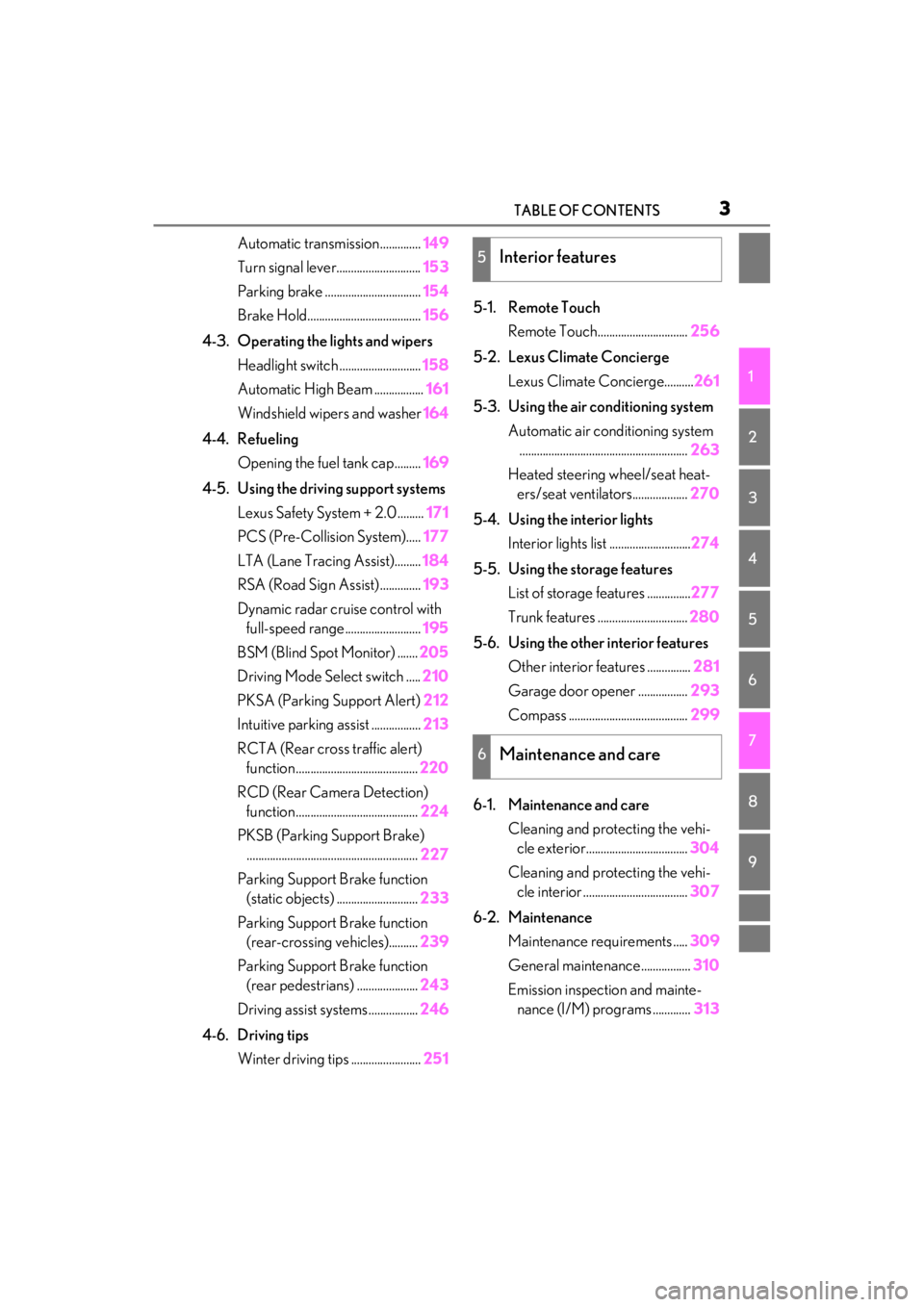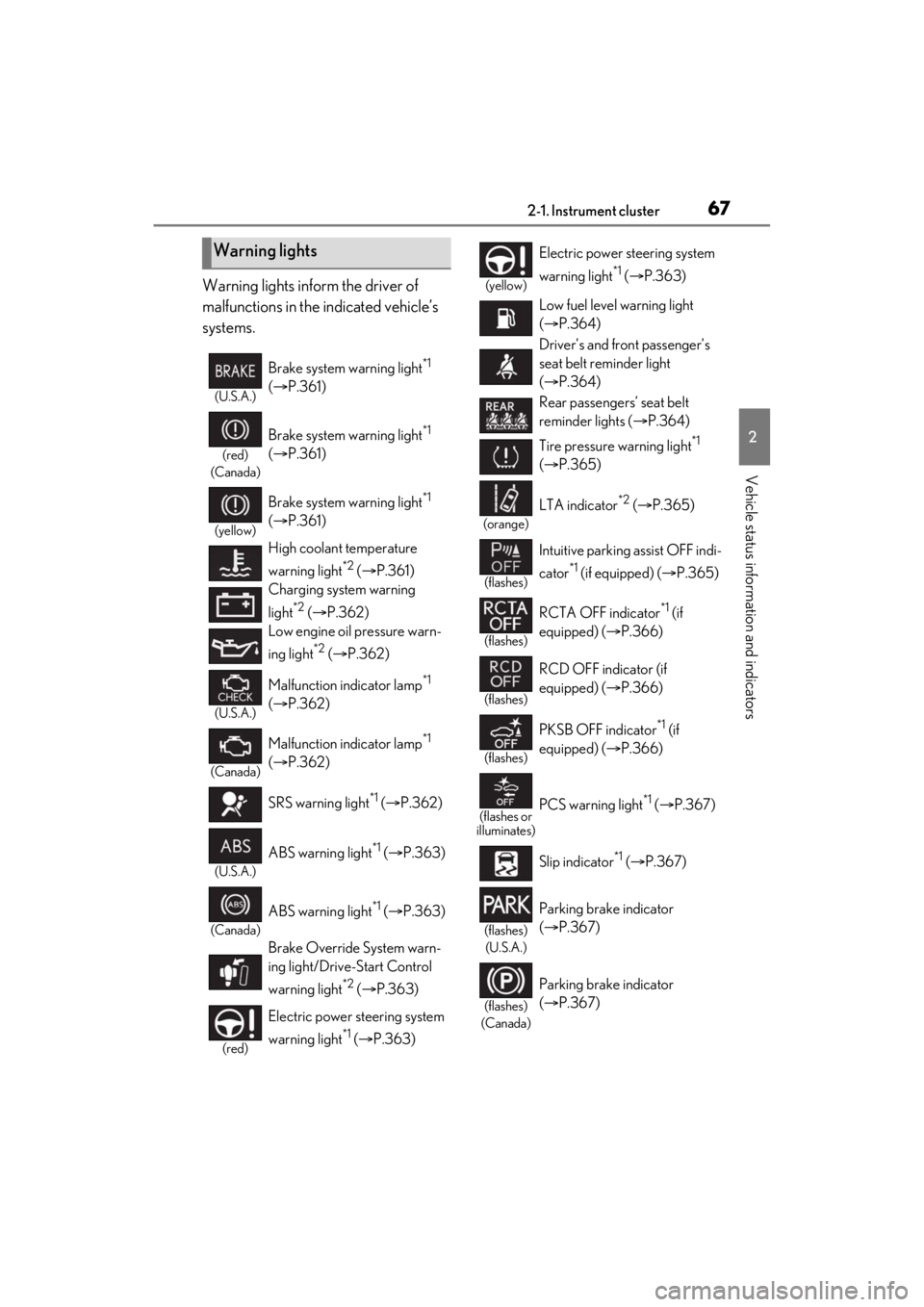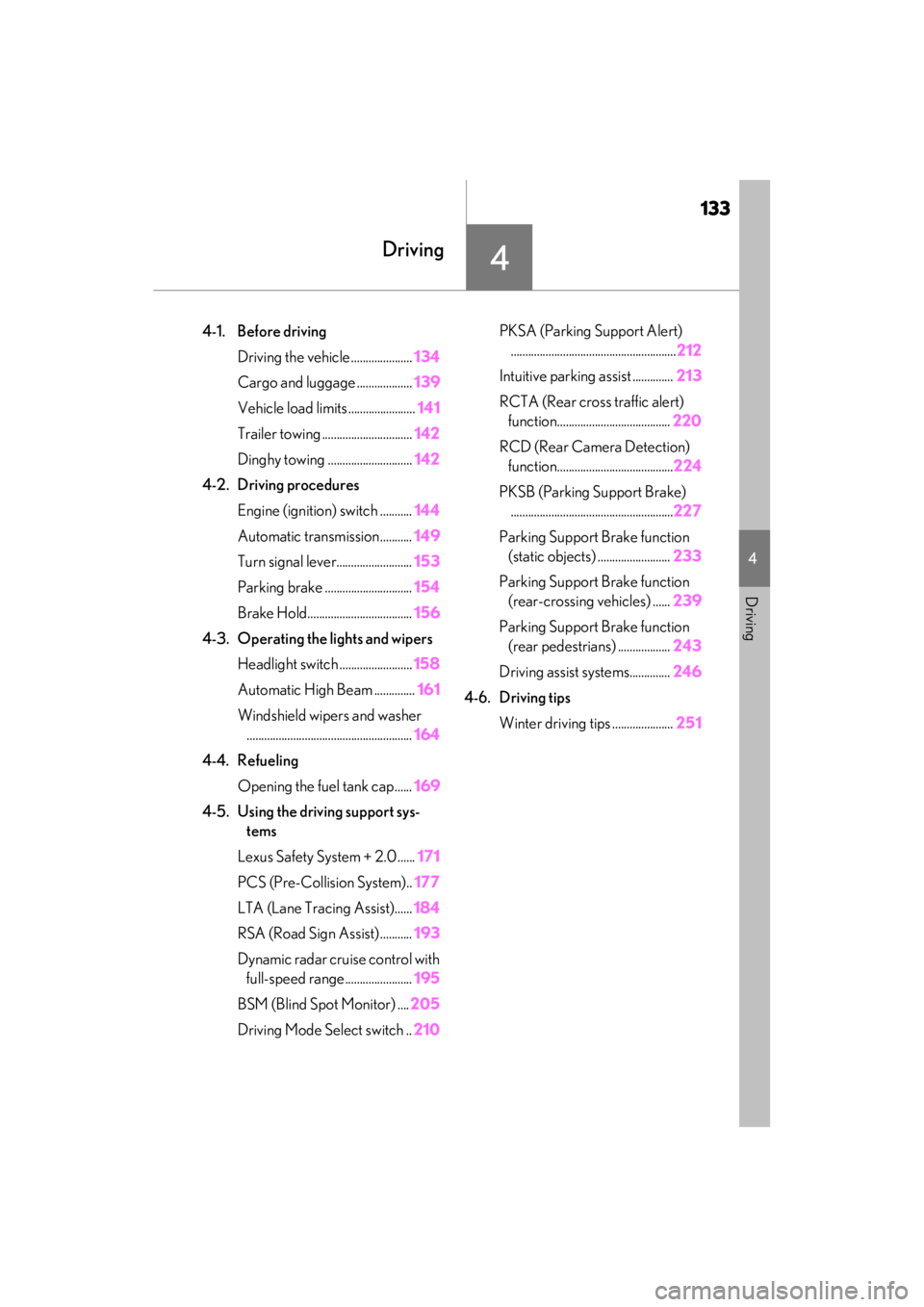2021 LEXUS ES350 brake light
[x] Cancel search: brake lightPage 3 of 464

3TABLE OF CONTENTS
1
2
3
4
5
6
7
8
9
Automatic transmission..............149
Turn signal lever............................. 153
Parking brake ................................. 154
Brake Hold....................................... 156
4-3. Operating the lights and wipers Headlight switch ............................ 158
Automatic High Beam ................. 161
Windshield wipers and washer 164
4-4. Refueling Opening the fuel tank cap......... 169
4-5. Using the driving support systems Lexus Safety System + 2.0 ......... 171
PCS (Pre-Collision System)..... 177
LTA (Lane Tracing Assist)......... 184
RSA (Road Sign Assist) .............. 193
Dynamic radar crui se control with
full-speed range.......................... 195
BSM (Blind Spot Monitor) ....... 205
Driving Mode Select switch ..... 210
PKSA (Parking Support Alert) 212
Intuitive parking assist ................. 213
RCTA (Rear cross traffic alert) function .......................................... 220
RCD (Rear Camera Detection) function .......................................... 224
PKSB (Parking Support Brake) ........................................................... 227
Parking Support Brake function (static objects) ............................ 233
Parking Support Brake function (rear-crossing vehicles).......... 239
Parking Support Brake function (rear pedestrians) ..................... 243
Driving assist systems ................. 246
4-6. Driving tips Winter driving tips ........................ 2515-1. Remote Touch
Remote Touch............................... 256
5-2. Lexus Climate Concierge Lexus Climate Concierge.......... 261
5-3. Using the air conditioning system Automatic air conditioning system.......................................................... 263
Heated steering wheel/seat heat- ers/seat ventilators................... 270
5-4. Using the interior lights Interior lights list ............................ 274
5-5. Using the storage features List of storage features ............... 277
Trunk features ............................... 280
5-6. Using the other interior features Other interior features ............... 281
Garage door opener ................. 293
Compass ......................................... 299
6-1. Maintenance and care Cleaning and protecting the vehi-cle exterior................................... 304
Cleaning and protecting the vehi- cle interior .................................... 307
6-2. Maintenance Maintenance re quirements .....309
General maintenance ...
.............. 310
Emission inspection and mainte- nance (I/M) programs ............. 313
5Interior features
6Maintenance and care
Page 15 of 464

15Pictorial index
Parking brake switch ............................................................................................. P.154
Applying/releasing ........................................................................................................... P.154
Precautions against winter season ............................................................................ P.252
Warning buzzer/message............................................................................................ P.372
Turn signal lever ......................................................................................................P.153
Headlight switch......................................................................................................P.158
Headlights/parking lights/tail lights/daytime running lights ........................... P.158
Automatic High Beam ....................................................................................................... P.161
Windshield wiper and washer switch ................................................................ P.164
Usage.......................................................................................................................................P.164
Adding washer fluid ......................................................................................................... P.3 25
Warning messages .......................................................................................................... P.372
Emergency flasher switch .................................................................................. P.352
Hood lock release lever ........................................................................................ P.316
Tilt and telescopic steering control swit ch/tilt and telescopic steering lock
release lever .............................................................................................................. P.11 9
Adjustment ..................................................................................................................... ........ P.119
Driving position memory
*1............................................................................................... P.114
Air conditioning system .......................................................................................P.263
Usage.......................................................................................................................... ........... P.263
Rear window defogger................................................................................................... P.264
Audio system
*2
Trunk opener main switch ....................................................................................P.105
*1: If equipped
*2: Refer to “NAVIGATION AND MULTIMEDIA SYSTEM OWNER’S MANUAL”.
E
F
G
H
I
J
K
L
M
Page 30 of 464

301-1. For safe use
Driver’s seat belt buckle switch
Airbag sensor assembly
“AIR BAG ON” and “AIR BAG OFF” indicator lights
Front passenger’s seat belt buckle switch
Front impact sensors
Your vehicle is equipped with ADVA NCED AIRBAGS designed based on the
US motor vehicle safety standards (FMVSS208). The airbag sensor assembly
(ECU) controls airbag deployment based on information obtained from the sen-
sors etc. shown in the system compon ents diagram above. This information
includes crash severity and occupant info rmation. As the airbags deploy, a chemi-
cal reaction in the inflators quickly fills the airbags with non-toxic gas to help
restrain the motion of the occupants.
■If the SRS airbags deploy (inflate)
●Slight abrasions, burns, bruising etc., may
be sustained from SRS airbags, due to the
extremely high speed deployment (infla-
tion) by hot gases.
●A loud noise and white powder will be
emitted.
●Parts of the airbag module (steering
wheel hub, airbag cover and inflator) as
well as the front seat s, parts of the front
and rear pillars, and r oof side rails may be
hot for several minutes. The airbag itself
may also be hot.
●The windshield may crack.
●All of the doors will be unlocked.
( P.96)
●The brakes and stop lights will be con-
trolled automatically. ( P.246)
●The interior lights will turn on automati-
cally. ( P.275)
●The emergency flashers will turn on auto-
matically. ( P.352)
●Fuel supply to the engine will be stopped.
( P.360)
●For Lexus Enform Safety Connect sub-
scribers, if any of the following situations
occur, the system is designed to send an
emergency call to the response center,
notifying them of the vehicle’s location
(without needing to push the “SOS” but- ton) and an agent will attempt to speak
with the occupants to ascertain the level
of emergency and assistance required. If
the occupants are unable to communi-
cate, the agent automatically treats the
call as an emergency and helps to dis-
patch the necessary emergency services.
(
P.55)
• An SRS airbag is deployed.
• A seat belt pretensioner is activated.
• The vehicle is involved in a severe rear- end collision.
■SRS airbag deployment conditions (SRS
front airbags)
●The SRS front airbags will deploy in the
event of an impact that exceeds the set
threshold level (the level of force corre-
sponding to an approximately 12 - 18
mph [20 - 30 km/h] frontal collision with
a fixed wall that does not move or
deform).
However, this threshold velocity will be
considerably higher in the following situ-
ations:
• If the vehicle strikes an object, such as a parked vehicle or sign pole, which can
move or deform on impact
• If the vehicle is involved in an underride collision, such as a collision in which the
front of the vehicle “underrides”, or goes
under, the bed of a truck
●Depending on the type of collision, it is
possible that only the seat belt preten-
N
O
P
Q
R
Page 67 of 464

672-1. Instrument cluster
2
Vehicle status information and indicators
Warning lights inform the driver of
malfunctions in the indicated vehicle’s
systems.
Warning lights
(U.S.A.)
Brake system warning light*1
( P.361)
(red)
(Canada)
Brake system warning light*1
( P.361)
(yellow)
Brake system warning light*1
( P.361)
High coolant temperature
warning light
*2 ( P.361)
Charging system warning
light
*2 ( P.362)
Low engine oil pressure warn-
ing light
*2 ( P.362)
(U.S.A.)
Malfunction indicator lamp*1
( P.362)
(Canada)
Malfunction indicator lamp*1
( P.362)
SRS warning light
*1 ( P.362)
(U.S.A.)
ABS warning light*1 ( P.363)
(Canada)
ABS warning light*1 ( P.363)
Brake Override System warn-
ing light/Drive-Start Control
warning light
*2 ( P.363)
(red)
Electric power st eering system
warning light
*1 ( P.363)
(yellow)
Electric power steering system
warning light
*1 ( P.363)
Low fuel level warning light
( P.364)
Driver’s and front passenger’s
seat belt re minder light
( P.364)
Rear passengers’ seat belt
reminder lights ( P.364)
Tire pressure warning light
*1
( P.365)
(orange)
LTA indicator*2 ( P.365)
(flashes)
Intuitive parking assist OFF indi-
cator
*1 (if equipped) ( P.365)
(flashes)
RCTA OFF indicator*1 (if
equipped) ( P.366)
(flashes)
RCD OFF indicator (if
equipped) (P.366)
(flashes)
PKSB OFF indicator*1 (if
equipped) ( P.366)
(flashes or
illuminates)PCS warning light*1 ( P.367)
Slip indicator
*1 ( P.367)
(flashes)
(U.S.A.)
Parking brake indicator
( P.367)
(flashes)
(Canada)
Parking brake indicator
( P.367)
Page 68 of 464

682-1. Instrument cluster
*1: These lights come on when the engine switch is turned to IGNITION ON
mode to indicate that a system check is
being performed. They will go off after
the engine is on, or after a few seconds.
There may be a malfunction in a system
if the lights do not come on, or go off.
Have the vehicle inspected by your
Lexus dealer.
*2: This light illuminates on the multi-infor- mation display.
The indicators inform the driver of the
operating state of the vehicle’s various
systems.
(flashes)
Brake hold operated indica-
tor
*1 ( P.368)
Master warning light
*1
( P.368)
WARNING
■If a safety system warning light does
not come on
Should a safety system light such as the
ABS and SRS warning light not come on
when you start the engine, this could
mean that these systems are not avail-
able to help protect you in an accident,
which could result in death or serious
injury. Have the ve hicle inspected by
your Lexus dealer immediately if this
occurs.
Indicators
Turn signal indicator ( P.153)
(U.S.A.)
Headlight indicator ( P.158)
(Canada)
Tail light indicator ( P.158)
Headlight high beam indicator
( P.160)
Automatic High Beam indicator
( P.161)
PCS warning light
*1, 2 ( P.177)
Cruise control indicator
( P.195)
Dynamic radar cruise control
indicator ( P.195)
Cruise control “SET” indicator
( P.195)
(white)
LTA indicator ( P.189)
(green)
LTA indicator (P.189)
(orange)
(flashes)LTA indicator ( P.189)
BSM outside rear view mirror
indicators
*1, 3 (if equipped)
( P.205, 220)
BSM indicator (if equipped)
( P.205)
Intuitive parking assist OFF indi-
cator
*1, 2 (if equipped)
( P.214)
RCTA OFF indicator
*1, 2 (if
equipped) ( P.220)
RCD OFF indicator
*2 (if
equipped) ( P.224)
PKSB OFF indicator
*1, 2 (if
equipped) ( P.228)
(flashes)
Slip indicator*1 ( P.247)
VSC OFF indicator
*1, 2
( P.247)
Page 69 of 464

692-1. Instrument cluster
2
Vehicle status information and indicators
Drive mode indicators
Except F SPORT models
F SPORT models
*1: These lights come on when the engine
switch is turned to IGNITION ON
mode to indicate that a system check is
being performed. They will go off after
the engine is on, or after a few seconds.
There may be a malfunction in a system
if the lights do not come on, or go off.
Have the vehicle inspected by your
Lexus dealer.
*2: This light comes on when the system is turned off.
*3: This light illuminates on the outside rear view mirrors.
*4: When the outside temperature is approximately 37°F (3°C) or lower,
this indicator will flash for approxi-
mately 10 seconds, then stay on.
*5: This light illuminates on the center panel.
Smart access system with push-
button start indicator (
P.144)
(U.S.A.)
Parking brake indicator
( P.154)
(Canada)
Parking brake indicator
( P.154)
Brake hold standby indicator
*1
( P.156)
Brake hold operated indica-
tor
*1 ( P.156)
Eco Driving Indicator Light
*1
( P.80)
Low outside temperature indi-
cator
*4 ( P.70, 73)
(U.S.A.)
“AIR BAG ON/OFF” indica-
tor
*1, 5 ( P.37)
(Canada)
“AIR BAG ON/OFF” indica-
tor
*1, 5 ( P.37)
Eco drive mode indicator
( P.210)
Sport mode indicator ( P.210)
Custom mode indicator
( P.210)
Eco drive mode indicator
( P.210)
Sport S mode indicator
( P.210)
Sport S+ mode indicator
( P.210)
Page 133 of 464

133
4
4
Driving
Driving
4-1. Before drivingDriving the vehicle ..................... 134
Cargo and luggage ................... 139
Vehicle load limits ....................... 141
Trailer towing ............................... 142
Dinghy towing ............................. 142
4-2. Driving procedures Engine (ignition) switch ........... 144
Automatic transmission........... 149
Turn signal lever.......................... 153
Parking brake .............................. 154
Brake Hold.................................... 156
4-3. Operating the lights and wipers Headlight switch ......................... 158
Automatic High Beam .............. 161
Windshield wipers and washer ......................................................... 164
4-4. Refueling Opening the fuel tank cap...... 169
4-5. Using the driving support sys- tems
Lexus Safety System + 2.0 ...... 171
PCS (Pre-Collision System).. 177
LTA (Lane Tracing Assist)...... 184
RSA (Road Sign Assist) ........... 193
Dynamic radar cruise control with full-speed range....................... 195
BSM (Blind Spot Monitor) .... 205
Driving Mode Select switch .. 210PKSA (Parking Support Alert)
......................................................... 212
Intuitive parking assist .............. 213
RCTA (Rear cross traffic alert) function....................................... 220
RCD (Rear Camera Detection) function........................................ 224
PKSB (Parking Support Brake) ........................................................ 227
Parking Support Brake function (static objects) ......................... 233
Parking Support Brake function (rear-crossing vehicles) ...... 239
Parking Support Brake function (rear pedestrians) .................. 243
Driving assist systems.............. 246
4-6. Driving tips Winter driving tips ..................... 251
Page 135 of 464

1354-1. Before driving
4
Driving
●A warning message is displayed on the
multi-information display while the sys-
tem is operating. ( P.363)
■Restraining sudden start (Drive-Start
Control)
●When the following unusual operation is
performed, the engine output may be
restrained.
• When the shift lever is shifted from R to
D, D to R, N to R, P to D, or P to R (D
includes S) with the accelerator pedal
depressed, a warning message appears
on the multi-information display. If a
warning message is shown on the multi-
information display, read the message
and follow the instructions.
• When the accelerator pedal is depressed
too much while the vehicle is in reverse.
●While Drive-Start Control is being acti-
vated, your vehicle may have trouble
escaping from the mud or fresh snow. In
such case, deactivate TRAC ( P.247)
to cancel Drive-Start Control so that the
vehicle may become able to escape from
the mud or fresh snow.
■Breaking in your new Lexus
To extend the life of the vehicle, observing
the following precautions is recommended:
●For the first 186 miles (300 km):
Avoid sudden stops.
●For the first 621 miles (1000 km):
• Do not drive at extremely high speeds.
• Avoid sudden acceleration.
• Do not drive continuously in low gears.
• Do not drive at a constant speed for extended periods.
■Operating your vehicle in a foreign
country
Comply with the relevant vehicle registra-
tion laws and confirm the availability of the
correct fuel. ( P.400)
WARNING
Observe the following precautions.
Failure to do so may result in death or
serious injury.
■When starting the vehicle
Always keep your foot on the brake
pedal while stopped with the engine run-
ning. This prevents the vehicle from
creeping.
■When driving the vehicle
●Do not drive if you are unfamiliar with
the location of the brake and accelera-
tor pedals to avoid depressing the
wrong pedal.
• Accidentally depressing the accelera- tor pedal instead of the brake pedal
will result in sudden acceleration that
may lead to an accident.
• When backing up, you may twist your body around, leading to a difficulty in
operating the pedals. Make sure to
operate the pedals properly.
• Make sure to keep a correct driving posture even when moving the vehicle
only slightly. This allows you to depress
the brake and accelerator pedals
properly.
• Depress the brake pedal using your right foot. Depressing the brake pedal
using your left foot may delay
response in an emer gency, resulting in
an accident.
●Do not drive the vehicle over or stop
the vehicle near flammable materials.
The exhaust system and exhaust gases
can be extremely hot. These hot parts
may cause a fire if there is any flamma-
ble material nearby.
●During normal driving, do not turn off
the engine. Turning the engine off
while driving will not cause loss of
steering or braking control, but the
power assist to these systems will be
lost. This will make it more difficult to
steer and brake, so you should pull
over and stop the vehicle as soon as it
is safe to do so.
However, in the event of an emer-
gency, such as if it becomes impossible
to stop the vehicle in the normal way:
P.352